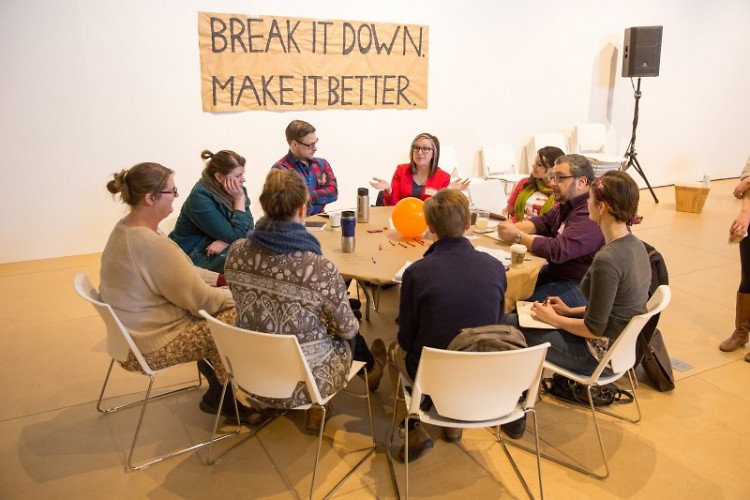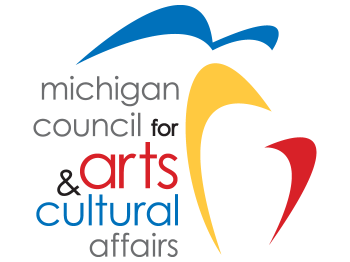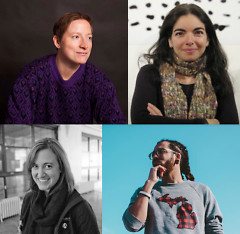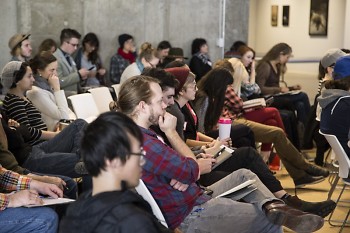The artistic community is always shifting and expanding; it is especially evident in Grand Rapids. West Michigan has many events driven by artists creating, making and selling work; including First Fridays, ArtPrize, Festival of the Arts, Art.Downtown, and the DisArt symposium. Shows like "Us Is Them” displaying currently at the UICA and Natural State featuring Ai Weiwei at Frederik Meijer Gardens, are challenging viewers and audiences by driving political, analytical, discussions about society. New galleries such as Lions & Rabbits, The Light Gallery, and Cerasus Studios are both owned and operated by artists. For a small, but mighty Midwestern city to be home to so many art events and spaces, it is important for all artists living and working in the area to have platforms to discuss all aspects of being a creative person. Break It Down | Make It Better seeks to be an answer for the artistic communities need to engage in conversations with one another.
This year the Break it Down | Make it Better event was designed by creatives, for creatives. Feedback from previous participants was taken into consideration in addition to fresh voices and new perspectives received from surveys. West Michigan artists, curators, art educators, venue coordinators and creative professionals submitted topics, and the result is a day of conversation about being a Michigan artist in 2017. “It’s a great opportunity to meet other artists and cultural producers, share and exchange thoughts, ideas, and experiences,” says Nayda Collazo-Llorens, an interdisciplinary visual artist and the Stuart & Barbara Padnos Distinguished Artist-in-Residence in the Department of Art and Design at Grand Valley State University. Collazo-Llorens is joined by three other speakers Omari Rush, Lora Robertson, and Janice Bond for a keynote discussion “Engaging Communities, Collaborative Dialogues Around Art.” For the rest of the day, artists and creative professionals will attend afternoon workshops and two dozen roundtable discussions.
At the heart of these discussions is the intention of building an active, inclusive and diverse community, driven by creativity. This mission is especially evident in the creative work of The Diatribe. Fable the Poet, described as the charismatic conductor, explains The Diatribe is: “A collective of teaching artists (Rooted in Poetry) that guide youth through social justice issues, and promote community engagement. We facilitate after school programs, school assemblies, and promote individual growth.” A few members from the Diatribe are leading a roundtable discussion about Engaging Youth. Wordsmith Rachel Gleason says, “Something that we teach the youth is that there is strength in vulnerability and a lot of good art has a vulnerable aspect to it. It is raw, it lets its guard down. And in that way art is unifying and can connect community members in different ways and at different levels.”
“I believe these types of discussions are important because they are both networking opportunities and real-world learning opportunities; a practical application of academic information. In other words, this type of learning in practice is more effective than traditional classroom learning.” Amanda Carmer Rainey, an Avenue for the Arts member and Admissions Officer at Kendall College of Art and Design of Ferris State University is leading a table concentrating on Best Practices for All Gallery Types. This year the conversations have been split into different theme tracks that participants can choose to follow, or mix and match what they attend, to fit whatever agenda they have in mind for their creative lives. The themes are Expanding Audiences, Professional Development, Funding the Arts, Artist Evolution, Off the Wall, Concentrating on Community and Curatorial Practices.
“Images are open to interpretation and can spark conversation. We desperately need civil, constructive conversation today,” Carmer Rainey adds. For community members interested in coming together to discuss art, activism, community, and engagement, tickets are still available. Break it Down | Make it Better is a series of events aimed at producing educational programming, discussions and professional development opportunities for artists, curators and venue coordinators in our community and region. These programs are presented through an ongoing partnership with the Avenue for the Arts, ArtPrize and the Urban Institute for Contemporary Arts.
The Avenue for the Arts is a neighborhood title for the South Division commercial corridor. We are residential, commercial and nonprofit groups working together in a creative community. We are residents in Heartside, and active participants in shaping change in our neighborhood. In 2005, we choose the Avenue for the Arts as a title to represent our commercial corridor and the projects and events that we create. Because the Avenue is powered by volunteers guest writers create our Rapidian content. Special thanks to JoLee Kirkikis, Avenue member, photographic artist and Art History alum from Kendall College of Art and Design of Ferris State University for contributing this piece.
The Rapidian, a program of the 501(c)3 nonprofit Community Media Center, relies on the community’s support to help cover the cost of training reporters and publishing content.
We need your help.
If each of our readers and content creators who values this community platform help support its creation and maintenance, The Rapidian can continue to educate and facilitate a conversation around issues for years to come.
Please support The Rapidian and make a contribution today.



